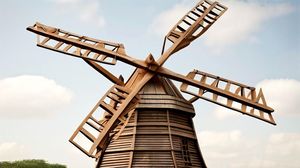
The Wimbledon Windmill is a striking landmark located on Wimbledon Common. Built in 1817, this iconic structure was originally used to grind grain, serving the local community with its vital milling services. Today, it stands as a museum, offering a fascinating glimpse into the rural history of the area and the intricate processes behind wind-powered milling.
One of the most interesting aspects of the Wimbledon Windmill is its unique design. It is a hollow post windmill, which means that the entire body of the mill pivots around a central post, allowing the sails to catch the wind regardless of its direction. This engineering marvel, although unusual, was practical in the variable climate of London.
The windmill operated successfully until 1864 when it was converted into residential apartments. This unexpected transformation highlights the adaptability of the structure and the resourcefulness of its owners, who repurposed the building in an era that was increasingly reliant on mechanical and industrial innovations.
After falling into disuse, the windmill was saved from dereliction in the early 20th century by local campaigners and has since been lovingly restored. It now houses a fascinating museum with exhibits spanning from the intricacies of windmill engineering to the vibrant history of Wimbledon Common.
A quirky feature of the Wimbledon Windmill is its status as a setting in various works of fiction. Notably, it played a part in the famous children's book "Little Noddy Goes to Toyland" by Enid Blyton, demonstrating the site's charming allure that has inspired authors and artists alike.

Making the Most of Your Visit:
Make sure to visit during the weekend afternoons when the windmill museum is open to the public. It's fascinating to see the model exhibits and learn about the history of milling and the Wimbledon Common itself.
If you're planning a family visit, the kids will love the interactive exhibits and the chance to try milling some grain themselves. It's both educational and fun, providing a hands-on experience of history in action.
Pack a picnic and enjoy it on the surrounding Wimbledon Common. The windmill is situated in a beautiful green space, perfect for a leisurely lunch surrounded by nature.
Don't miss the chance to explore the displays on the ground floor that delve into the local history and the natural environment of Wimbledon Common, adding a rich context to your visit.
For photography enthusiasts, the windmill offers some picturesque opportunities, especially at sunrise or sunset. Capture the stunning structure silhouetted against the sky or with the lush common in the background.

Visiting Times & Costs:
The Wimbledon Windmill is open to the public primarily during the summer months. Generally, it welcomes visitors on weekends, specifically Saturdays and Sundays, from 2 pm to 5 pm. However, scheduling can be subject to change, so it is advised to check current opening times before planning your visit.
Entrance to the windmill and its museum is free, though donations are greatly appreciated to support the maintenance and running of the site. There might be additional charges for special exhibitions or events.
In terms of accessibility, visitors should note that the windmill has several floors accessible only by narrow staircases, which may not be suitable for those with mobility issues. The surrounding Wimbledon Common, however, is generally accessible with pathways suitable for wheelchairs and prams.

Address & Map:

Nearby:























